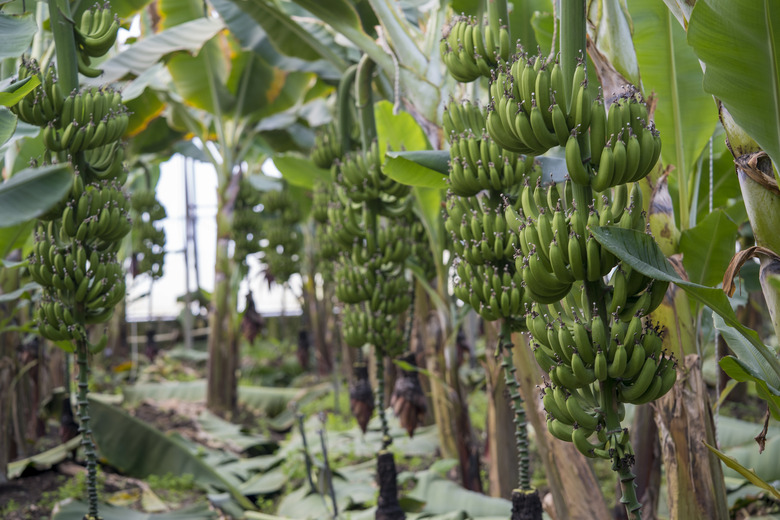How Do I Tell The Difference Between A Banana Plant And A Plantain Plant?
An edible banana plant (Musa acuminata) and an edible plantain plant (Musa x paradisiaca) are both members of genus Musa and can be easily grown in your home or garden (perennials in USDA zones 10-11). However, there are some major differences between the plants. Knowing how to tell the difference between the two will help you to better understand the fruits you're growing.
Tip
Both bananas and plantains belong to the same plant family and genus, but differences in the appearance of their flowers and fruits will tell you the type of plant you're dealing with.
Differences in Flowers
Differences in Flowers
Banana plants and plantain plants have a similar appearance in terms of a larger, thicker stem and dramatically wide leaves, with similar potential mature heights of 30 feet. When environmental conditions are optimal, both banana and plantain plants can produce a new leaf every week or so. After the plants have matured, they will produce flowers that eventually lead to fruits. There are two types of flowers on both plants: the females, which develop into fruit, and the males, which are fewer in number and nonfruiting.
Banana plants produce a large, cone-shaped flower that is actually multiple flower buds. As it blooms, this stalk opens, revealing the small flowers and eventually the beginnings of banana fruits. Plantain plants first produce female flowers in purple clusters, which eventually become the plantain fruit without the need for pollination. Afterward, banana plants follow with male flower blooms, which are rarer in plantains.
Differences in Fruit
Differences in Fruit
Banana plants produce classic dessert bananas — sweet, slightly starchy fruits that are extremely popular. Bananas tend to be curved in appearance and start out green, turning yellow as they ripen and eventually brown or black if they become overripe. Plantain fruits are somewhat similar to bananas in appearance, although they tend to be longer, larger and straighter.
The main difference in terms of the fruits, though, is their taste. Bananas are sweet and are mostly eaten raw, although they can be used in cakes and desserts. Plantains have much more starch, are usually cooked before eating and are far more savory and tougher in texture. You can eat plantains raw, but it's best to wait until they're extremely ripe with almost black skin, which is when they become sweeter and more tender.
Caring for Plantains and Bananas
Caring for Plantains and Bananas
The care needed for banana plants and plantain plants is similar. Both plants require rich, well-drained soil, and a high level of moisture is essential. Adding a layer of mulch over the top of the soil can boost the soil's water retention. Keep the soil consistently moist but make sure the roots of either plant are never sitting in stagnant water, as this can cause rot.
Both plants require a good amount of sunlight and warm temperatures and can be brought indoors during the winter if they're potted and cold weather threatens. If they're growing in your landscape and can't be moved, you can prune back any large leaves to minimize surface area. Adding a burlap blanket over the plant or protecting the soil layers with straw may help a banana or plantain plant survive colder temperatures.
